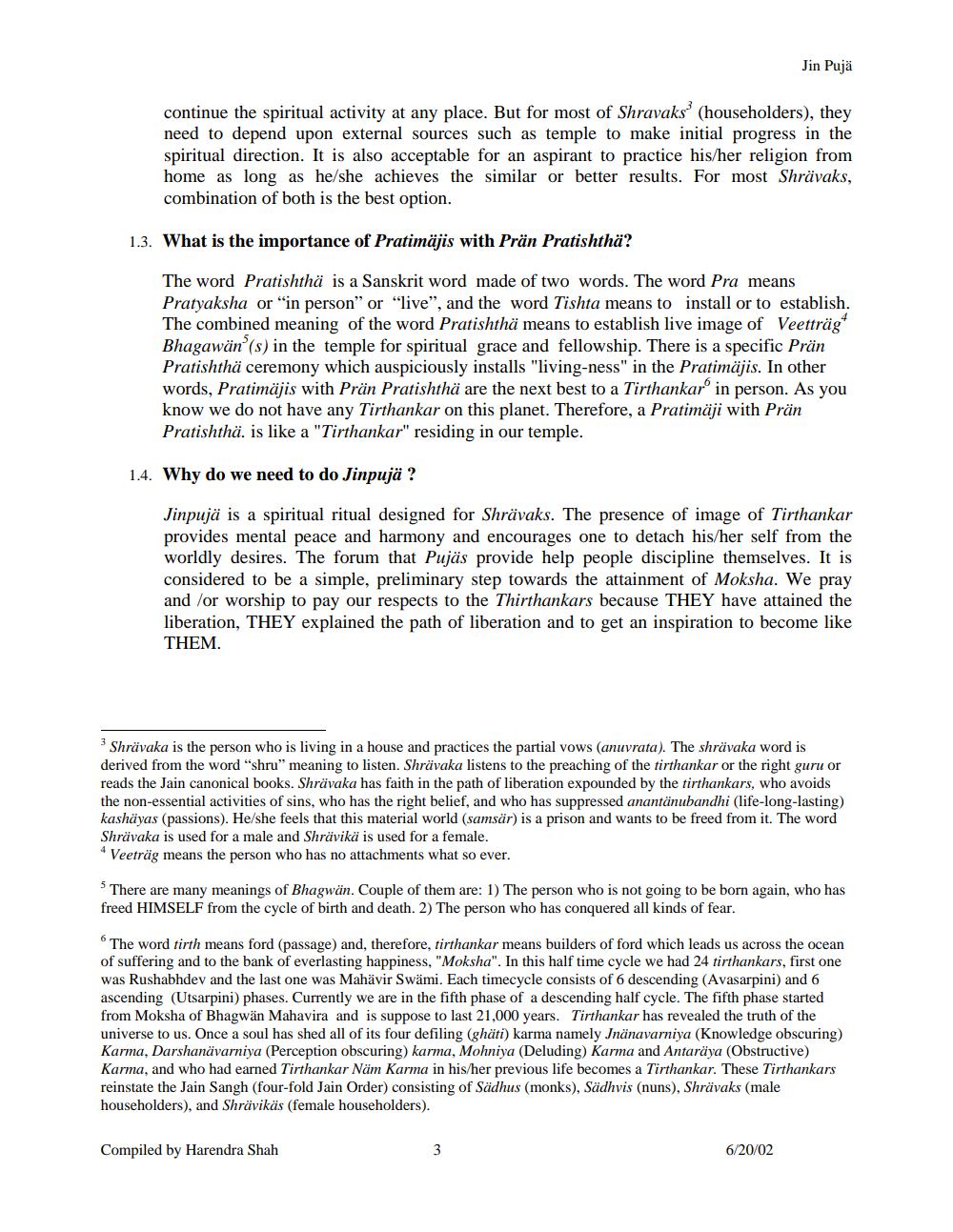Book Title: Jin puja Author(s): Harendra Shah Publisher: USA Jain Center Northern Calfornia View full book textPage 3
________________ Jin Pujä continue the spiritual activity at any place. But for most of Shravaks (householders), they need to depend upon external sources such as temple to make initial progress in the spiritual direction. It is also acceptable for an aspirant to practice his/her religion from home as long as he/she achieves the similar or better results. For most Shrävaks, combination of both is the best option. 1.3. What is the importance of Pratimäjis with Prän Pratishthä? The word Pratishthä is a Sanskrit word made of two words. The word Pra means Pratyaksha or "in person" or "live", and the word Tishta means to install or to establish. The combined meaning of the word Pratishthä means to establish live image of Veetträg* Bhagawan(s) in the temple for spiritual grace and fellowship. There is a specific Prän Pratishthä ceremony which auspiciously installs "living-ness" in the Pratimäjis. In other words, Pratimäjis with Prän Pratishthä are the next best to a Tirthankar in person. As you know we do not have any Tirthankar on this planet. Therefore, a Pratimäji with Prän Pratishthä. is like a "Tirthankar" residing in our temple. 1.4. Why do we need to do Jinpujä? Jinpujä is a spiritual ritual designed for Shrävaks. The presence of image of Tirthankar provides mental peace and harmony and encourages one to detach his/her self from the worldly desires. The forum that Pujäs provide help people discipline themselves. It is considered to be a simple, preliminary step towards the attainment of Moksha. We pray and /or worship to pay our respects to the Thirthankars because THEY have attained the liberation, THEY explained the path of liberation and to get an inspiration to become like THEM. Shrävaka is the person who is living in a house and practices the partial vows (anuvrata). The shrävaka word is derived from the word "shru" meaning to listen. Shrävaka listens to the preaching of the tirthankar or the right guru or reads the Jain canonical books. Shrävaka has faith in the path of liberation expounded by the tirthankars, who avoids the non-essential activities of sins, who has the right belief, and who has suppressed anantänubandhi (life-long-lasting) kashäyas (passions). He/she feels that this material world (samsär) is a prison and wants to be freed from it. The word Shrävaka is used for a male and Shrävikä is used for a female. * Veeträg means the person who has no attachments what so ever. $ There are many meanings of Bhagwän. Couple of them are: 1) The person who is not going to be born again, who has freed HIMSELF from the cycle of birth and death. 2) The person who has conquered all kinds of fear. The word tirth means ford (passage) and, therefore, tirthankar means builders of ford which leads us across the ocean of suffering and to the bank of everlasting happiness, "Moksha". In this half time cycle we had 24 tirthankars, first one was Rushabhdev and the last one was Mahävir Swämi. Each timecycle consists of 6 descending (Avasarpini) and 6 ascending (Utsarpini) phases. Currently we are in the fifth phase of a descending half cycle. The fifth phase started from Moksha of Bhagwan Mahavira and is suppose to last 21,000 years. Tirthankar has revealed the truth of the universe to us. Once a soul has shed all of its four defiling (ghäti) karma namely Jnänavarniya (Knowledge obscuring) Karma, Darshanävarniya (Perception obscuring) karma, Mohniya (Deluding) Karma and Antaräya (Obstructive) Karma, and who had earned Tirthankar Näm Karma in his/her previous life becomes a Tirthankar. These Tirthankars reinstate the Jain Sangh (four-fold Jain Order) consisting of Sädhus (monks), Sadhvis (nuns), Shrävaks (male householders), and Shrävikäs (female householders). Compiled by Harendra Shah 6/20/02Page Navigation
1 2 3 4 5 6 7 8 9 10 11 12 13 14 15 16
